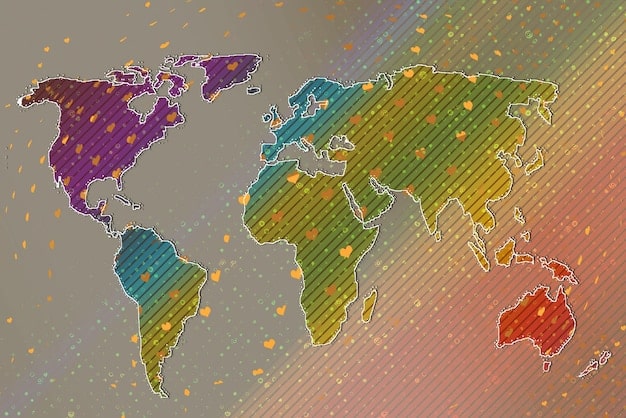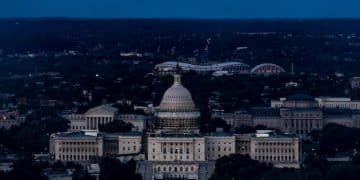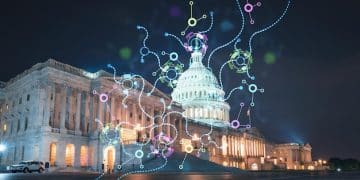Geopolitics & US Immigration: A 5-Year Outlook

Advertisements
The confluence of global conflicts, economic shifts, and climate change will significantly influence and potentially reshape US immigration policy over the next five years, prioritizing national security and economic interests amidst evolving humanitarian concerns.
Advertisements
The intricate tapestry of international relations and domestic priorities constantly evolves, and few domains are as sensitive to these shifts as immigration policy. Understanding how will the current geopolitical landscape shape US immigration policy in the next 5 years requires a nuanced examination of global flashpoints, economic dynamics, and humanitarian imperatives influencing American shores.
The Weight of Global Instability on Borders
Current global instability, marked by conflicts, political upheavals, and humanitarian crises, exerts immense pressure on traditional immigration frameworks. The United States, as a leading global power, often finds itself at the nexus of these crises, with direct implications for its border security and refugee policies.
Advertisements
The escalating conflicts in Eastern Europe and the Middle East, for instance, have triggered unprecedented displacement, creating massive refugee flows. These events challenge existing international protocols and place significant demands on host nations, including the US, to respond in ways that balance compassion with national security concerns.
Conflict Zones and Asylum Claims
Conflict zones are primary drivers of asylum claims. Individuals fleeing persecution, violence, or war often seek refuge in stable countries, and the US remains a prime destination due to its historical embrace of immigrants and refugees. This influx directly impacts the processing capacity of immigration systems and can lead to policy adjustments.
- Increased asylum applications: Wars in Ukraine, Gaza, and other regions lead to a surge in individuals seeking protection.
- Strained resources: Border agencies and humanitarian organizations face immense pressure to process and support arrivals.
- Policy responses: Governments may implement expedited processing or, conversely, impose stricter entry requirements.
Navigating these complexities requires agile policy responses that can adapt to rapid changes in global displacement patterns. The humanitarian imperative to offer refuge often collides with domestic political considerations regarding border management and national security.
Simultaneously, the US government must contend with the political ramifications of these movements. Public opinion on immigration is often polarized, with some advocating for more open borders and others demanding stricter controls. This internal debate shapes the legislative agenda and influences the allocation of resources for immigration enforcement and services.
Economic Shifts and Labor Market Demands
Beyond geopolitical conflicts, global economic shifts play a critical role in shaping US immigration policy. The interplay between international trade, technological advancements, and domestic labor demands directly influences who is admitted into the country and under what conditions.
A burgeoning economy might necessitate more foreign workers to fill labor shortages, particularly in sectors like agriculture, technology, and healthcare. Conversely, periods of economic downturn or high unemployment could lead to calls for more restrictive immigration policies to protect domestic jobs.
High-Skilled Immigration and Tech Competition
The global race for technological supremacy and innovation often hinges on attracting and retaining highly skilled talent. Countries compete to draw the brightest minds, and immigration policies for skilled workers become a key competitive differentiator.
- Demand for STEM professionals: The US tech sector relies heavily on foreign-born engineers and scientists.
- Visa programs: Programs like the H-1B visa are crucial for bringing in skilled workers, though they face ongoing scrutiny.
- Global competition: Other nations are actively developing incentives to attract similar talent, necessitating the US to remain competitive.
Policy adjustments in this area often focus on streamlining visa processes, expanding quotas, or developing new pathways for professionals in critical industries. The goal is to ensure the US remains a global leader in innovation and economic growth.
Furthermore, economic partnerships and trade agreements can indirectly influence immigration flows. As global supply chains evolve and international investment patterns shift, the demand for specific types of labor can change, prompting policy adaptations to facilitate necessary worker mobility.

Climate Change and Environmental Migration
While often overshadowed by immediate conflicts, climate change is emerging as a powerful, long-term driver of migration, profoundly impacting how the US will approach immigration policy in the coming years. Rising sea levels, extreme weather events, and resource scarcity are displacing populations, creating new categories of migrants and associated policy challenges.
Areas particularly vulnerable to climate impacts, such as parts of Central America and the Caribbean, are experiencing increased internal displacement and cross-border movement. This phenomenon could lead to more individuals seeking refuge in the US, not necessarily from conflict, but from uninhabitable conditions.
The concept of “climate refugees” lacks formal international recognition under existing conventions, presenting a significant legal and humanitarian dilemma. The US will need to consider how its legal frameworks and humanitarian aid programs adapt to this growing demographic.
Policy Frameworks for Climate-Induced Migration
Developing specific policy frameworks for climate-induced migration is crucial. This involves not only reactive measures, such as providing humanitarian assistance to displaced populations, but also proactive strategies, including international cooperation on climate adaptation and mitigation efforts to reduce future displacement.
- Defined pathways: Exploring new visa categories or protections for those displaced by climate events.
- International cooperation: Collaborating with affected nations to build resilience and manage internal displacement.
- Resource allocation: Directing aid to support communities vulnerable to climate change, reducing the impetus for migration.
The challenges are multifaceted, requiring a delicate balance between securing borders, upholding humanitarian principles, and addressing the root causes of climate displacement. The next five years will likely see increased debate and potential policy innovation in this complex area, as the impacts of environmental changes become undeniable.
This includes considering how existing immigration laws, designed for political or economic migrants, apply to those fleeing environmental degradation. A comprehensive approach may involve both domestic policy adjustments and robust engagement in international climate diplomacy to address the issue at its source.
The Evolving Role of Technology in Border Management
Technology’s role in border management and immigration enforcement is rapidly expanding and will continue to shape US policy. From advanced surveillance systems to biometrics and AI-driven data analysis, technological advancements offer both opportunities for enhanced security and challenges related to privacy and civil liberties.
Increased investment in border technology aims to create more efficient and secure processes, from tracking entries and exits to identifying potential threats. This can reduce reliance on human personnel in some areas, potentially streamlining operations and reducing costs.
However, the ethical implications of pervasive surveillance and the potential for algorithmic bias in decision-making processes are significant concerns that will require careful consideration and policy oversight. Balancing security needs with individual rights remains a complex undertaking.
AI and Predictive Analytics in Immigration
Artificial intelligence and predictive analytics are poised to revolutionize how immigration applications are processed, risks are assessed, and borders are managed. These technologies can process vast amounts of data, identifying patterns and anomalies that might not be apparent to human analysts.
- Enhanced screening: AI can rapidly analyze traveler data to flag potential security risks.
- Streamlined processing: Automation can accelerate visa and asylum application reviews.
- Ethical considerations: Concerns about algorithmic bias, data privacy, and transparency in decision-making.
The integration of advanced technologies will necessitate new regulations and ethical guidelines to ensure fair and equitable application of these tools. Public trust and accountability in technological solutions will be paramount for their successful implementation in immigration management.
As technology continues to advance, so too will the methods of those seeking to circumvent immigration controls. This ongoing cat-and-mouse game will drive further innovation in border security, with policy constantly adapting to counteract emerging threats and challenges.
Shifting Alliances and Bilateral Relations
The US immigration policy is not solely an internal affair; it is deeply intertwined with its foreign policy and bilateral relations. Shifting geopolitical alliances, trade agreements, and diplomatic efforts with key nations directly influence how the US approaches immigration from specific regions.
When the US strengthens alliances with certain countries, it may lead to more relaxed visa requirements or increased cooperation on issues like refugee resettlement. Conversely, strained relations can result in stricter travel restrictions or heightened scrutiny for nationals from particular regions.
For example, cooperation with Mexico and Central American nations on border security and migration management is a perennial concern. The effectiveness of these partnerships directly impacts the flow of migrants and asylum seekers arriving at the US southern border.
Cooperation on Border Security and Regional Stability
Effective immigration management often relies on strong bilateral and multilateral cooperation. Sharing intelligence, coordinating enforcement efforts, and collaborating on regional development initiatives can help address the root causes of migration and manage flows more effectively.
- Joint border operations: Collaborating with neighboring countries to manage shared borders.
- Information sharing: Exchanging intelligence on human trafficking and smuggling networks.
- Development aid: Investing in stability and economic opportunities in origin countries to reduce outward migration pressure.
The success of these cooperative efforts hinges on diplomatic relations and shared strategic interests. Over the next five years, the US will likely continue to leverage its foreign policy tools to foster greater international collaboration on migration issues, recognizing that unilateral solutions are often insufficient for complex global challenges.
Changes in diplomatic priorities, the emergence of new regional powers, or shifts in international economic dynamics can all ripple through immigration policy, demanding flexible and responsive approaches to complex challenges that defy simple solutions.
Domestic Political Landscape and Public Opinion
Perhaps the most immediate and influential factor shaping US immigration policy is the domestic political landscape and the prevailing public opinion. Immigration has been, and likely will remain, a highly contentious issue in American politics, often serving as a significant dividing line between political parties and ideologies.
Electoral cycles frequently see immigration become a central campaign theme, with candidates adopting vastly different stances on border security, legal immigration pathways, and the treatment of undocumented individuals. The outcome of elections can dramatically alter the direction of policy.
Public sentiment, influenced by media narratives, economic conditions, and personal experiences, plays a crucial role in shaping legislative priorities. Periods of heightened concern over national security or economic competition often correlated with calls for more restrictive policies.
Political Polarization and Legislative Stalemate
The high degree of political polarization on immigration issues often leads to legislative stalemates, making comprehensive reform difficult. This can result in a reliance on executive actions or judicial rulings to implement significant policy changes, leading to inconsistency and uncertainty.
- Partisan divides: Fundamental disagreements between political parties on immigration solutions.
- Executive actions: Presidents often use executive orders to bypass legislative gridlock, leading to frequent policy shifts between administrations.
- Judicial challenges: Immigration policies are frequently challenged in courts, leading to prolonged legal battles and uncertain outcomes.
The interplay between public opinion, political rhetoric, and legislative action will continue to be a dominant force in defining the contours of US immigration policy. Understanding these dynamics is essential for anticipating potential changes and their impact on individuals and communities.
Ultimately, the next five years will be characterized by a constant interplay between global pressures and domestic political realities. Each will exert its influence, ensuring that US immigration policy will remain a complex and evolving domain, reflecting the ongoing debates about national identity, security, and humanitarian responsibility.

| Key Influence | Brief Description |
|---|---|
| ⚔️ Global Conflicts | Escalating wars and humanitarian crises drive asylum applications and strain border resources, demanding flexible policy responses. |
| 💼 Economic Shifts | Labor market demands, especially in tech and healthcare, influence high-skilled immigration policies to maintain global competitiveness. |
| 🌪️ Climate Change | Environmental displacement leads to a new category of migrants, urging policies for “climate refugees” and international cooperation. |
| 🏛️ Domestic Politics | Polarization and electoral cycles significantly shape border security and legal immigration pathways, often leading to policy shifts. |
Frequently Asked Questions About US Immigration Policy
▼
Climate change is expected to increase “environmental migration” as people flee areas affected by extreme weather, sea-level rise, and resource scarcity. The US will likely face growing pressure to develop new policies or expand existing protections for these displaced populations, possibly leading to new visa categories or humanitarian considerations for climate-induced migrants.
▼
Technology will play an increasingly prominent role, with greater reliance on AI, biometrics, and advanced surveillance systems. These tools aim to enhance security, streamline processing, and manage border flows more efficiently. However, their implementation will also raise critical questions about data privacy, algorithmic bias, and ethical oversight, shaping future regulations.
▼
Yes, economic conditions will significantly influence high-skilled immigration. Periods of robust economic growth and labor shortages, particularly in tech and specialized fields, often lead to calls for expanded visa programs (e.g., H-1B) to attract global talent. Conversely, economic downturns might prompt discussions about protecting domestic jobs, potentially leading to more restrictive policies.
▼
International conflicts are direct drivers of asylum rates. People fleeing war, persecution, and political instability seek safety, often in countries like the US. Escalating conflicts in regions such as Eastern Europe or the Middle East lead to immediate surges in asylum applications, straining processing capabilities and prompting humanitarian responses and policy adjustments.
▼
Intense domestic political polarization often creates legislative stalemates, making comprehensive immigration reform challenging. This gridlock pushes policy changes towards executive actions or judicial rulings, leading to unpredictable and often temporary shifts in immigration laws. The political climate will continue to dictate if and how significant legislative overhauls occur.
Conclusion: An Interconnected Future for US Immigration
The trajectory of US immigration policy over the next five years will not be a linear path but rather a complex interplay of global events, economic forces, environmental challenges, technological advancements, and persistent domestic political dynamics. The current geopolitical landscape, marked by conflict and unprecedented displacement, will continue to test and redefine existing frameworks, pushing the nation to balance humanitarian imperatives with national security interests. Simultaneously, economic shifts and the race for global talent will drive debates on skilled immigration, while the undeniable impacts of climate change will introduce new categories of migrants into the policy discourse. Ultimately, US immigration policy will serve as a barometer for both its internal priorities and its response to an increasingly interconnected and volatile world, demanding adaptable, comprehensive, and compassionate approaches to these evolving challenges.





